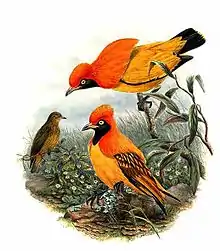Masked bowerbird
The masked bowerbird (Sericulus aureus) is one of the most brilliantly coloured bowerbirds. The male is a medium-sized bird, up to 25 cm long, with flame orange and golden yellow plumage, elongated neck plumes and yellow-tipped black tail. It builds an "avenue-type" bower with two side walls of sticks. The female is an olive brown bird with yellow or golden below.
| Masked bowerbird | |
|---|---|
 | |
| Males displaying to a female masked bowerbird, Sericulus aureus, illustrated by John Gould (1804–1881) | |
| Scientific classification | |
| Kingdom: | Animalia |
| Phylum: | Chordata |
| Class: | Aves |
| Order: | Passeriformes |
| Family: | Ptilonorhynchidae |
| Genus: | Sericulus |
| Species: | S. aureus |
| Binomial name | |
| Sericulus aureus | |
| Synonyms | |
| |
The flame bowerbird is distributed in and endemic to rainforests of New Guinea. This species is the first bowerbird described by naturalists. Because of the male's beautifully coloured plumage, it was previously thought to be a bird-of-paradise. Indeed, the male flame bowerbird also has a courtship display along with his bower. He twists his tails and his wings to the side, and then shakes his head quickly.
The masked bowerbird is evaluated as least concern on the IUCN Red List of Threatened Species.
References
- BirdLife International 2016. Sericulus aureus. The IUCN Red List of Threatened Species 2016: e.T103683932A93931853. https://doi.org/10.2305/IUCN.UK.2016-3.RLTS.T103683932A93931853.en. Downloaded on 17 August 2019.

